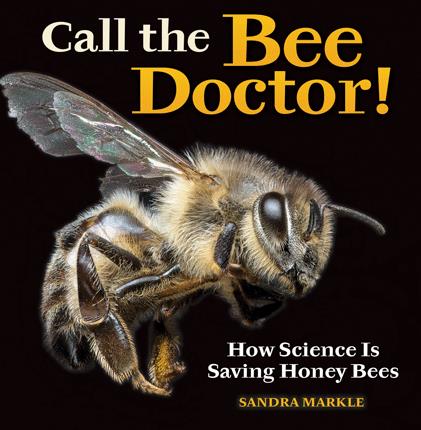| Call the bee doctor! : how science is saving honey bees (Sandra Markle's science discoveries) Author: Markle, Sandra | ||
| Price: $27.98 | ||
Summary:
Since Colony Collapse Disorder began decimating honey bees in 2006, scientists have been researching its causes and how to prevent it. Get an up-to-date look at what we know and how new innovations are saving honey bees.
Reviews:
Kirkus Reviews (+) (09/15/24)
School Library Journal (10/04/24)
Full Text Reviews:
School Library Journal - 10/04/2024 Gr 4–8—Beginning in 1998, European beekeepers were devastated to find that honey bees were disappearing from their hives. This phenomenon was named Colony Collapse Disorder (CCD), and by 2006 it had spread to the United States. As honey bees are responsible for pollinating many of the crops which provide food, the disappearance of honey bees due to CCD could have potentially devastating global consequences. Markle takes readers on a deep dive with apiologists (bee scientists) to learn about bees, what causes CCD, and how to prevent it from decimating more bee colonies. Markle begins by explaining the anatomy of a bee colony and how each type of bee is integral to the hive's functioning; a description of plant pollination by bees is also presented. She then explains how apiologists have determined the four likely causes for CCD: pesticides, poor nutrition, parasites, and pathogens. She provides explanations as to why these are the likely causes and what can be done to mitigate each problem. Although complex concepts are introduced, Markle presents the necessary background details readers need to follow along. Information is well organized with photographs and illustrations adding visual interest. A list of additional sources is included. VERDICT A great resource for research projects and nature enthusiasts, recommended for middle grade science collections. Finally, some good news about the future of honey bees!—Ragan O'Malley - Copyright 2024 Publishers Weekly, Library Journal and/or School Library Journal used with permission.
School Library Journal - 10/04/2024 Gr 4–8—Beginning in 1998, European beekeepers were devastated to find that honey bees were disappearing from their hives. This phenomenon was named Colony Collapse Disorder (CCD), and by 2006 it had spread to the United States. As honey bees are responsible for pollinating many of the crops which provide food, the disappearance of honey bees due to CCD could have potentially devastating global consequences. Markle takes readers on a deep dive with apiologists (bee scientists) to learn about bees, what causes CCD, and how to prevent it from decimating more bee colonies. Markle begins by explaining the anatomy of a bee colony and how each type of bee is integral to the hive's functioning; a description of plant pollination by bees is also presented. She then explains how apiologists have determined the four likely causes for CCD: pesticides, poor nutrition, parasites, and pathogens. She provides explanations as to why these are the likely causes and what can be done to mitigate each problem. Although complex concepts are introduced, Markle presents the necessary background details readers need to follow along. Information is well organized with photographs and illustrations adding visual interest. A list of additional sources is included. VERDICT A great resource for research projects and nature enthusiasts, recommended for middle grade science collections. Finally, some good news about the future of honey bees!—Ragan O'Malley - Copyright 2024 Publishers Weekly, Library Journal and/or School Library Journal used with permission.



